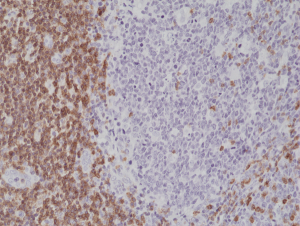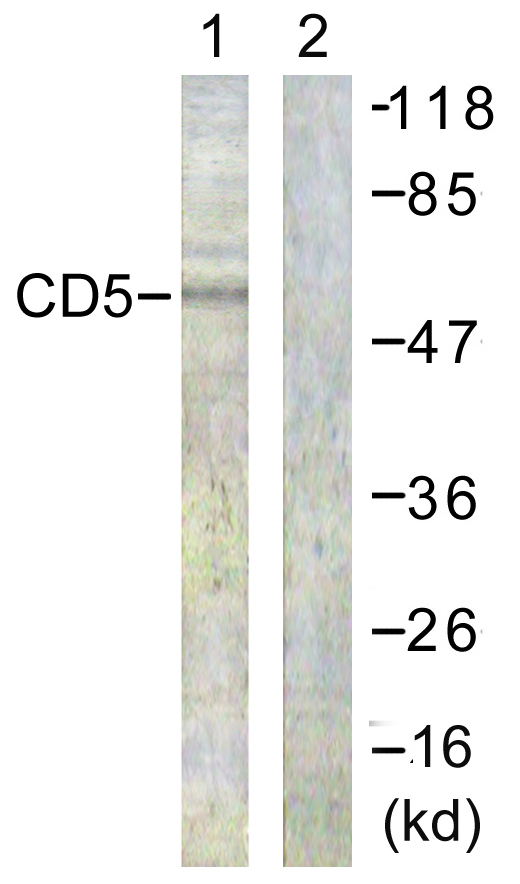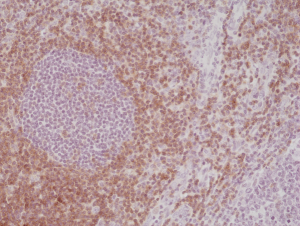
Immunohistochemical staining of formalin fixed and paraffin embedded human tonsil tissue section using anti-CD5 rabbit monoclonal antibody (Clone RM314) at a 1:1000 dilution.
anti-CD5 (human), Rabbit Monoclonal (RM314)
REV-31-1200-00
ApplicationsWestern Blot, ImmunoHistoChemistry
Product group Antibodies
ReactivityHuman
TargetCD5
Overview
- SupplierRevMAb Biosciences
- Product Nameanti-CD5 (human), Rabbit Monoclonal (RM314)
- Delivery Days Customer10
- ApplicationsWestern Blot, ImmunoHistoChemistry
- CertificationResearch Use Only
- ClonalityMonoclonal
- Clone IDRM314
- Gene ID921
- Target nameCD5
- Target descriptionCD5 molecule
- Target synonymsLEU1, T1, T-cell surface glycoprotein CD5, CD5 antigen (p56-62), epididymis secretory sperm binding protein, lymphocyte antigen T1/Leu-1
- HostRabbit
- IsotypeIgG
- Protein IDP06127
- Protein NameT-cell surface glycoprotein CD5
- Scientific DescriptionCD5 is a 67 kDa human T-lymphocyte single-chain transmembrane glycoprotein, also known as Leu-1, Ly-1 and T1. It is a member of the scavenger receptor superfamily found on T cells, thymocytes, B cell subsets, chronic B lymphocytic leukemia (B-Cells), peripheral blood dendritic cells and on many T-cell leukemias and lymphomas. CD5 also reacts with a subpopulation of activated B-cells and may act as a receptor in regulating T-cell proliferation. CD5 modulates T and B cell receptor signaling, thymocyte maturation and T-B cell interactions upon binding to ligands such as CD72. CD5 is found on 95% of thymocytes and 72% of peripheral blood lymphocytes. In lymph nodes, the main reactivity is observed in T cell areas. CD5 is expressed by many T cell leukemia, lymphomas and activated T cells. Diseases associated with CD5 dysfunction include thymus cancer and Richters Syndrome. - Recombinant Antibody. This antibody reacts to human CD5. Applications: WB, IHC. Source: Rabbit. Liquid. 50% Glycerol/PBS with 1% BSA and 0.09% sodium azide. CD5 is a 67 kDa human T-lymphocyte single-chain transmembrane glycoprotein, also known as Leu-1, Ly-1 and T1. It is a member of the scavenger receptor superfamily found on T cells, thymocytes, B cell subsets, chronic B lymphocytic leukemia (B-Cells), peripheral blood dendritic cells and on many T-cell leukemias and lymphomas. CD5 also reacts with a subpopulation of activated B-cells and may act as a receptor in regulating T-cell proliferation. CD5 modulates T and B cell receptor signaling, thymocyte maturation and T-B cell interactions upon binding to ligands such as CD72. CD5 is found on 95% of thymocytes and 72% of peripheral blood lymphocytes. In lymph nodes, the main reactivity is observed in T cell areas. CD5 is expressed by many T cell leukemia, lymphomas and activated T cells. Diseases associated with CD5 dysfunction include thymus cancer and Richters Syndrome.
- ReactivityHuman
- Storage Instruction-20°C
- UNSPSC12352203






